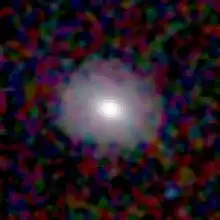| NGC 106 | |
|---|---|
 SDSS image of NGC 106 | |
| Observation data (J2000 epoch) | |
| Constellation | Pisces |
| Right ascension | 00h 24m 43.753s[1] |
| Declination | −05° 08′ 55.71″[1] |
| Redshift | 0.020211[2] |
| Heliocentric radial velocity | 6059[2] |
| Distance | 199 Mly (61.1 Mpc)[2] |
| Apparent magnitude (B) | 14.46[3] |
| Characteristics | |
| Type | Sa: pec[2] |
| Size | 64,800 ly (19,880 pc)[2][note 1] |
| Apparent size (V) | 1.3′ × 0.6′[2] |
| Other designations | |
| PGC 1551, 2MASX J00244375-0508557[3] | |
NGC 106 is a lenticular galaxy estimated to be about 270 million light-years away in the constellation of Pisces. It was discovered by Francis Leavenworth in 1886 and its apparent magnitude is 14.5.[4]
Notes
- ↑ 2MASS Ks band used.

NGC 106 in infrared
References
- 1 2 Skrutskie, Michael F.; Cutri, Roc M.; Stiening, Rae; Weinberg, Martin D.; Schneider, Stephen E.; Carpenter, John M.; Beichman, Charles A.; Capps, Richard W.; Chester, Thomas; Elias, Jonathan H.; Huchra, John P.; Liebert, James W.; Lonsdale, Carol J.; Monet, David G.; Price, Stephan; Seitzer, Patrick; Jarrett, Thomas H.; Kirkpatrick, J. Davy; Gizis, John E.; Howard, Elizabeth V.; Evans, Tracey E.; Fowler, John W.; Fullmer, Linda; Hurt, Robert L.; Light, Robert M.; Kopan, Eugene L.; Marsh, Kenneth A.; McCallon, Howard L.; Tam, Robert; Van Dyk, Schuyler D.; Wheelock, Sherry L. (1 February 2006). "The Two Micron All Sky Survey (2MASS)". The Astronomical Journal. 131 (2): 1163–1183. Bibcode:2006AJ....131.1163S. doi:10.1086/498708. ISSN 0004-6256. S2CID 18913331.
- 1 2 3 4 5 6 "NED results for object NGC 0106". National Aeronautics and Space Administration / Infrared Processing and Analysis Center. Retrieved 16 March 2017.
- 1 2 "NGC 106". SIMBAD. Centre de données astronomiques de Strasbourg. Retrieved 16 March 2017.
- ↑ "NGC Objects: NGC 100 - 149".
External links
 Media related to NGC 106 at Wikimedia Commons
Media related to NGC 106 at Wikimedia Commons
This article is issued from Wikipedia. The text is licensed under Creative Commons - Attribution - Sharealike. Additional terms may apply for the media files.